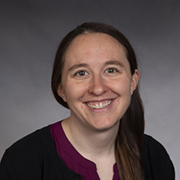Seminar
The importance of more complex isoprene and terpene chemistry for simulating surface ozone in the southeastern U.S. at varying horizontal resolutions

Rebecca Schwantes
NOAA CSL and CU CIRES
Wednesday, 27 May 2020
10:00 am Mountain Time
webinar only
Abstract
Ozone is a greenhouse gas and air pollutant that is harmful to human health and plants. During the summer in the southeastern U.S., many models are biased high for surface ozone compared to observations. Here, due to the high biogenic emissions in the southeastern US, more comprehensive and updated isoprene and terpene chemistry is added into CESM/CAM-chem (Community Earth System Model/Community Atmosphere Model with full chemistry) to evaluate the impact of chemistry on simulated ozone. A new configuration of CESM/CAM-chem has also been developed with the capability of regional refinement down to 14 km over the continental U. S. This new configuration along with the updated isoprene and terpene chemistry allows us to evaluate how horizontal resolution and chemical complexity impact ozone and ozone precursors as compared to field campaign observations. We highlight the importance of chemical complexity in accurately simulating surface ozone at varying horizontal resolutions and in particular at finer horizontal resolutions where processes and emissions are better resolved.
Rebecca (Becky) Schwantes joined the NOAA CSL Regional Chemical Modeling group in April 2020. Becky has a PhD in Environmental Science and Engineering from CalTech, where she worked with John Seinfeld and Paul Wennberg on the chemistry of organic trace gases and secondary organic aerosols in the laboratory and with models. She has been at NCAR for the past 3.5 years, first as a postdoc with the Advanced Study Program and later as a Project Scientist in Atmospheric Chemistry Observations and Modeling (ACOM), where she built updated chemical schemes for isoprene, terpene, and alkane oxidation for use in regional and global models. At NOAA, Becky will develop the chemical capabilities in NOAA's state-of-the-art modeling systems and evaluate these models with field and satellite observations.
ALL Seminar attendees agree not to cite, quote, copy, or distribute material presented without the explicit written consent of the seminar presenter. Any opinions expressed in this seminar are those of the speaker alone and do not necessarily reflect the opinions of NOAA or CSL.